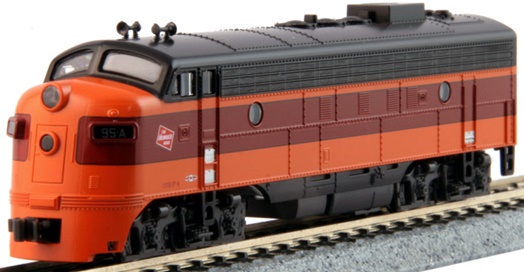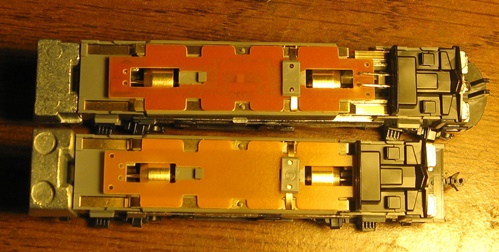

Introduced: 2017
These FP7 locomotives were released in concert with Kato's Milwaukee Road Olympian Hiawatha passenger train. They are available either DCC-Ready or with a factory installed DCC decoder. Internally, these models are quite similar to Kato's earlier F3 ad F7 models (in fact, sharing many of the same parts). The main difference is the longer chassis -

The chassis is one big hunk of metal (IE not split-frame). The open-sided motor is 5-pole and straight-wound. Each driveshaft is equipped with a small flywheel. The worms seat inside of bearing blocks (mounted inside of plastic brackets clipped to the chassis) and are turned by secondary metal driveshafts plugged into the flywheels. All eight wheels provide pickup (no traction tires). Pickup is of the "low friction" ilk (IE pointy-ended axles inside of dimpled axle wipers). Vertical extensions off the axle wipers transfer current to metal strips clipped to the top of the chassis. The strips tuck into a plastic bracket on the rear end and are held down by the plastic cab interior detail on the front end (Kato's "shock absorber" pickup system of recent vintage). A plastic clip holds the metal motor contacts to the contact strips. The lightboard (which can be swapped out for a decoder) is equipped with a directional LED for the dual headlights and numberboards. The lighting is orange/amber (as opposed to blue/white).

All four axles are geared and all gearing is plastic. The wheels are blackened and low profile (no problems on Atlas C55 track). The couplers are Kato's proprietary automatic/magnetic knuckle couplers (truck-mounted on the back and chassis-mounted on the front).

Plastic window inserts clipped to the insides of the shell hold the shell to the chassis (bumps in the chassis insert into holes in the inserts). Bits of light-conducting plastic inside the shell illuminate the headlights and numberboards.

As we've come to expect from Kato, performance is flawless in every way. Pickup is perfect and throttle response is nimble. They run smoothly and quietly at all throttle levels. Slow speed creep is impressive, and although the top-end speed is quite high, that just seems to be par for the course for Kato. Pulling power is very strong, with mine comfortably able to haul around thirty assorted 50' freight cars on level track (pulling the light and free-rolling nine car Olympian Hiawatha passenger train doesn't even cause it to break a sweat). No problems with any of the wheels derailing and no problems on sharp (9.75" radius) curves. Overall, these are superb models - both in terms of looks and performance.
Note - a new F7B (featuring a winterization hatch) was also part of the 2017 Milwaukee Road Olympian Hiawatha release -

As noted previously, the F7B models employ a slightly different chassis/mechanism and are thus covered elsewhere in this encyclopedia.
Prototype -
The Milwaukee Road used a total of three different locomotives to pull the consist between Chicago and Olympia, WA in the early 50's - two electrics (used on electrified portions of the journey) and the EMD FP7 - a specialized variation of the F7A which was lenghtened to accomodate a larger water resevoir for its steam generators (a necessity for long distance passenger service like that of the Olympian Hiawatha). While E units could also have filled this role (and did, in later years), their A1A truck design (spreading their weight and giving them less traction) made them less than ideal for handling the steep grades of the Milwaukee's route through the Rocky Mountains. For the Olympian Hiawatha release, Kato has made a new FP7A locomotive and a retooled version of the F7B featuring a winterization hatch (a necessity for trips through the northern US and across the Rockies!)
Shell Removal -
As noted above, the window inserts clipped inside the shell are what hold the shell to the chassis. So, insert some toothpicks (or whatever) between the inserts and the chassis to free up the chassis bumps and the shell should readily slide up and off.
Grade: A